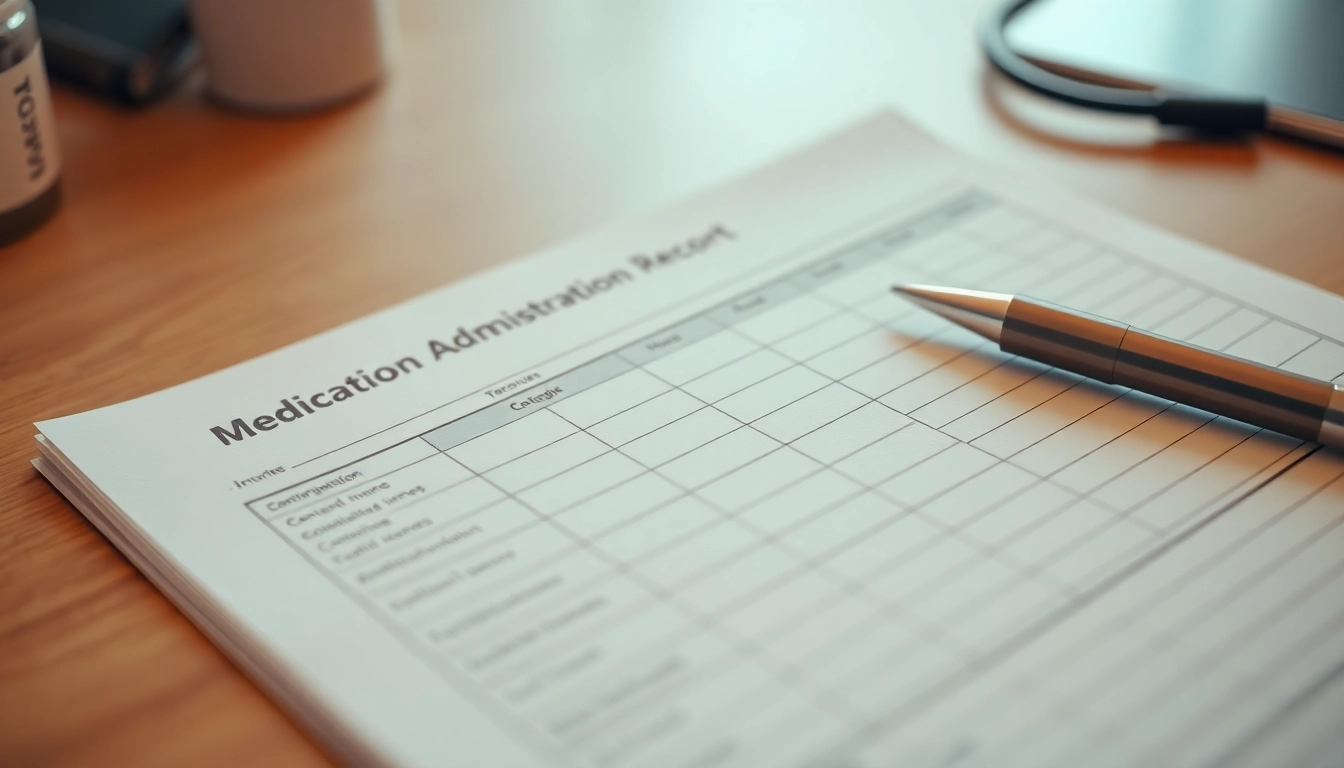Understanding Medication Administration Records
Medication administration records (MAR) play a crucial role in the healthcare continuum. A Medication administration record is more than just a log; it is a standardized tool that organizes essential information about a patient’s prescribed medications. It serves as a vital communication tool among healthcare providers, ensuring that they keep track of every detail concerning patients’ medication regimens.
What is a Medication Administration Record?
A Medication Administration Record (MAR) is essentially a document that outlines all medications prescribed to a patient, including when and how they should be administered. It is widely used in various healthcare settings, such as hospitals, nursing homes, and private care facilities. The MAR contributes significantly to patient safety by providing a formalized record of medications administered, which can reduce errors—both in prescribing and administration.
The Importance of Accurate Documentation
Accurate documentation on the MAR is critical for preventing medication errors that can result in adverse patient outcomes. A well-maintained MAR ensures that healthcare providers are aware of what medications a patient is receiving, including dosages and timings. The implication of missing or incorrect information could be dire: improper medication administration can lead to dangerous drug interactions, allergic reactions, or therapeutic failures.
A study published in the Journal of Nursing Care Quality highlights that approximately 1.5 million people are affected by medication errors annually in the United States, with thousands requiring hospitalization due to adverse drug events.
Key Components of an Effective MAR
For a MAR to be effective, it must contain several key components:
- Patient Information: Details such as name, date of birth, and unique identification numbers.
- Medication Details: This includes the name of the medication, dosage strength, quantity prescribed, and the route of administration (oral, IV, etc.).
- Schedule and Timing: Exact times and dates when medications are to be administered.
- Administration Records: Signatures or initials of the healthcare providers who administer the medication, along with notes on any refusal or changes.
- Allergies and Special Considerations: Information about any known allergies and specific instructions regarding patient conditions.
How to Create a Medication Administration Record
Step-by-Step Guide to Filling Out a MAR
Creating a Medication Administration Record entails several crucial steps:
- Gather Patient Information: Collect the necessary demographic and medical information about the patient.
- List Medications: Input all current medications, including those being administered, the frequency, and the route.
- Set Administration Times: Define clear time schedules for medication administration.
- Provide Special Instructions: Include any pertinent information regarding allergies or dietary restrictions.
- Review for Accuracy: Ensure all entries are accurate before finalizing the MAR.
Common Mistakes to Avoid
Creating and maintaining a MAR is not without its challenges. Here are common pitfalls to avoid:
- Inaccurate Information: Ensure all medication names, dosages, and administration routes are correct.
- Overlooking Updates: Remember to update the MAR whenever there is a change in prescriptions or patient status.
- Lack of Signatures: Ensure each administration is logged with the signature of the responsible person to maintain accountability.
- Ignoring Patient Allergies: Always include a section on allergies; it is critical for patient safety.
Templates and Resources for MAR Creation
Utilizing templates can simplify the creation of MARs. Many healthcare facilities provide standardized templates tailored to their specific requirements. Online resources also offer printable and customizable MAR templates for home healthcare workers or caregivers, allowing them to create their own logs efficiently. These templates often include fields for patient information, medication lists, dosage, and frequency, as well as sections for comments regarding patient responses or side effects.
Best Practices for Using Medication Administration Records
Ensuring Compliance with Healthcare Standards
Adherence to established healthcare standards is paramount in managing MARs. Compliance with regulations set forth by organizations like the Joint Commission or the Centers for Medicare & Medicaid Services (CMS) can impact a facility’s accreditation status. Facilities must regularly review their MAR practices to ensure they align with the latest guidelines.
Regular Review and Maintenance of MARs
Continuous review and maintenance of MARs are essential for accuracy and safety. Regular audits can help identify and rectify discrepancies that might arise from human error. An effective strategy includes setting up periodic checks and designating staff responsible for the ongoing accuracy of MAR documentation.
Training Staff on MAR Usage
Regular training sessions for staff involved in medication administration are fundamental. Educating staff about the importance of MARs, best practices for documentation, and the consequences of errors can significantly reduce medication-related mishaps. Simulation training scenarios can also be beneficial in reinforcing proper MAR usage.
Enhancing Patient Safety with Medication Administration Records
Tracking Medication Errors and Interactions
One of the primary goals of employing a comprehensive MAR system is to minimize medication errors. By tracking administration logs, healthcare providers can identify potential interactions between medications, and ensure that any risky combinations are avoided. Regularly updating patient information can significantly enhance this tracking capability.
Collaborative Communication Among Healthcare Providers
The MAR serves as a communication bridge among healthcare providers. It ensures that all team members—including nurses, pharmacists, and physicians—have access to the same medication information. Such transparency promotes cohesive care and can facilitate better patient outcomes through coordinated efforts.
Utilizing Technology in MAR Management
With technological advancements, many healthcare facilities are transitioning to electronic MARs (eMARs). These digital systems can streamline the entire medication administration process, providing real-time updates and alerts about medications. eMAR systems can also reduce the chances of human error associated with manual entries, promote more effective data sharing, and enhance patient safety overall.
Case Studies and Examples of Effective MAR Usage
Real-world Applications in Various Healthcare Settings
Several case studies illustrate the effective use of MARs in various healthcare environments. For instance, a nursing home in California implemented an eMAR system, which led to a 45% reduction in medication errors over a six-month period. This success can be attributed to improved tracking capabilities and better communication among caregivers.
Success Stories in Reducing Medication Errors
Healthcare institutions that have embraced comprehensive MAR practices have witnessed impressive declines in medication errors. A hospital in Texas documented a 30% reduction in adverse drug events after implementing a strict MAR policy alongside enhanced staff training on medication administration and documentation. Such success stories underscore the importance of diligent MAR management.
Lessons Learned and Future Directions for MAR Implementation
The insights gained from various implementations of MARs highlight critical lessons for future applications. Primary among these is the importance of ongoing education for all staff involved in medication management. Additionally, organizations should continuously evaluate and integrate feedback from frontline staff to improve MAR processes. Future advancements in technology and integration of artificial intelligence could further enhance the efficacy of MARs, turning them into dynamic tools that automatically track and predict medication requirements based on patient data.






